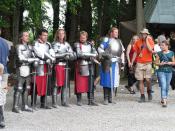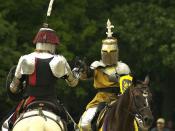When we think of the word "chivalry," we automatically visualize images of the mythical King Arthur and his Knights of the Round Table and images of heavily armored knights rescuing damsels in distress. However, what most people often seem to overlook is that chivalry was a code of conduct specifically designed to accommodate the harsh lifestyle and hierarchical order of society during the Middle Ages. In the minds of medieval aristocrats, chivalry was the most logical explanation in ensuring the preservation of their state of power and control that was in jeopardy in such a disorganized society. Nonetheless, chivalry was much more than just a means of controlling a chaotic environment; it was a code that became a way of life for the knight, who would become a figure to be admired for all time. One must often wonder if chivalry, which characterized a time period that has captured the heart of so many people across the world, would have any usefulness in modern society.
Unfortunately, chivalry would not be applicable in our society, which has so drastically revolutionized both socially and culturally from the Middle Ages.
In medieval Europe power was extremely decentralized, so the aristocrats had to develop a means of controlling their inferiors. Over hundreds of years a system called feudalism evolved as the easiest way for the nobles to protect themselves and their land holdings. Feudalism was a hierarchical system that controlled the social, political, and economic systems of medieval life. The hierarchy was based on mutual obligations, which allowed the nobles to control large areas of land. The lord would give parts of his land to knights in exchange for military service and loyalty. This obligation of military service and loyalty would become deeply rooted in the code of chivalry.
Chivalry mainly pertained...


